Abstract
Smart manufacturing uses robots and artificial intelligence techniques to minimize human interventions in manufacturing activities. Inspection of the machine’ working status is critical in manufacturing processes, ensuring that machines work correctly without any collisions and interruptions, e.g., in lights-out manufacturing. However, the current method heavily relies on workers onsite or remotely through the Internet. The existing approaches also include a hard-wired robot working with a computer numerical control (CNC) machine, and the instructions are followed through a pre-program path. Currently, there is no autonomous machine tending application that can detect and act upon the operational status of a CNC machine. This study proposes a deep learning-based method for the CNC machine detection and working status recognition through an independent robot system without human intervention. It is noted that there is often more than one machine working in a representative industrial environment. Therefore, the SiameseRPN method is developed to recognize and locate a specific machine from a group of machines. A deep learning-based text recognition method is designed to identify the working status from the human–machine interface (HMI) display.
1. Introduction
With current labor shortages and high costs, workers’ health, safety, and product quality may be compromised to compensate for manufacturing productivity [1]. Most manufacturing activities, such as machine tending tasks, are low-tech, repetitive, and dull, so workers can easily be replaced. With the development of robots, they are gradually being applied to machine tending tasks by collaborating with operators and even replacing workers to load and unload the raw parts to the machines. Recently, numerous research and development have been carried out and contributed to the robotic system in smart manufacturing [2,3,4,5,6,7]. Since robots can sense and respond to different scenarios for various manufacturing tasks, collaborative robots (cobots) have been widely implemented to relieve workers from risky, tedious, and repetitive manufacturing tasks [8]. In addition, it ensures high throughput rates and low costs [9].
Collaborative robots work in four different manners according to different collaborative environments [10], which are: (1) Coexistence: the robot and operator are in the same environment but generally do not interact with each other; (2) synchronized: the robot and worker are in the same workspace, but at different times; (3) cooperation: the worker and robot are in the same workspace at the same time, but each focuses on separate tasks; and, (4) collaboration: the robot and operator execute the same task, which means the action of the one has immediate consequences on the other. However, these four types of cobots still suffer from some challenges and drawbacks. Safety is the primary concern. Although some perception sensors are utilized on cobots to avoid injuries, operators must be careful all the time working with cobots if they move too fast. Moreover, cobots are often dedicated and fixed for a particular machine, and programmed for a specific task. It is an inefficient use of factory space and causes high costs to satisfy all manufacturing activities. In addition, it requires experienced engineers to reprogram the cobots to meet different production requirements when changing the manufacturing tasks.
The autonomous mobile manipulator (AMM) is proposed to extend the capabilities of conventional collaborative robots [11]. The architecture of AIMM is a robot arm mounted upon a mobile platform, which combines locomotion capability with manipulation ability. Since it combines collaborative and mobile robot characteristics, it is more flexible and adaptable to changes in tasks or environments. Although AMM can perform more manufacturing tasks than traditional cobots cannot, there is still a need for experienced operators to be onsite to assist the AMM in finding the target machines, checking the machine’s working status, and taking emergency actions in case of problems. For example, the robot does not load raw material properly.
As discussed in [12], smart devices and intelligent solutions can significantly improve the manufacturing process with artificial intelligence and imaging equipment development. They have gradually become a hot topic in smart manufacturing [13]. In [14], authors proposes an intelligent perceiving and planning system based on deep learning for a 7-DoF manipulator with a vision system. The vision system and designed intelligent process enhance collaboration ability through recognizing the target objects and improving the efficiency of robot planning. In [15], a collaborative robotics framework for top view surveillance is proposed. This study adopts the pre-trained deep learning models for object detection and localization to assist human operators in managing and controlling different applications. However, there is a challenge to recognize objects because the appearance of objects change significantly due to the change in camera position and shooting angle, which results in weak performance. In [16], authors develop a deep learning-based object detection method for the mobile robot manipulator in small and medium-sized enterprises production. This study applies region convolutional neural networks to recognize and localize the charging station and printing machine to achieve automatic tag production. In addition, it designs a human detection algorithm for the manipulator to increase safety while collaborating with operators.
Most recent studies and existing applications in smart manufacturing adopt mobile manipulators with the vision system and designed object detection methods to improve manufacturing production safety, efficiency, and intelligence. In those studies, humans often take great responsibility to control and operate robots through computer programs. Consequently, imitating the humans’ behavior, such as the “eye-brain-hand” process, is necessary to realize intelligent and autonomous manufacturing production truly and has become a widespread trend [14]. Therefore, this study proposes a deep learning-based intelligent manufacturing approach, aiming to achieve true intelligence and autonomous manufacturing production and machine tending. Compared with other solutions, the benefits of the proposed approach are low costs and high efficiency for small and medium-sized enterprises. In addition, this approach can be applied in lights-out manufacturing to reduce the workload for operators who need to tend machines and tackle the problems on the production floor. In the current study, an autonomous mobile manipulator with a vision system is adopted. The main objectives of this work are to develop an intelligent object detection method for the target CNC machine and HMI display detection in a complex environment and to design a text recognition method for the machine’s working status recognition to further assist in autonomous robot decision-making and problems handling.
The remainder of this paper is organized as follows: in Section 2, an overview of object detection and text recognition is presented. Section 3 explains the methodology of the proposed intelligent manufacturing approach for automatic machine detection and working status recognition. The case studies and results are demonstrated in Section 4. Section 5 outlines some limitations and potential future work. Finally, conclusions are presented in Section 6.
2. Literature Review
2.1. Object Detection
With the development of computer vision technology, object detection has been applied to many areas, including face detection, pedestrian detection, and traffic sign/light detection. Intelligent manufacturing mainly utilizes object detection techniques, such as quality management, product sorting, packaging, and assembly line. There are two categories of object detection given in recent research: traditional object detection methods and deep learning-based detection methods.
2.1.1. Traditional Object Detection Methods
Most classical object detection methods are usually developed based on low-level and mid-level features, such as color, shapes, edges, and contours. In the late 1990s and early 2000s, there were several milestones in object detection methods dominated by handcrafted features. Scale Invariant Feature Transform (SIFT) is one of them which transforms an image into a wide set of locally scale-invariant features. These scale-invariant features are invariant to image translation, rotation, scaling, illumination, occlusion, and 3D projection. Highly distinctive scale-invariant keypoints are further proposed to match individual features with features from known objects, and then the clusters belonging to the same object are identified through the Hough transform finally verified by least squares. In [17], a local feature descriptor, Histogram of Oriented Gradients (HOG), was first proposed. It counts the occurrences of gradient orientation in localized portions based on a dense grid of uniformly spaced cells and uses overlapping local contrast normalizations to improve accuracy. Despite being similar to SIFT descriptors, it is a significant improvement and gives excellent results for human detection. Because of the advantages of HOG, it has been an important architecture for many object detection methods. As an extension of HOG, the Deformable Part-based Model (DPM) [18] is the best classical object detection method. DPM achieves improvement in both precision and efficiency compared with the previous methods. It considers an object as a global template covering an entire object and a collection of part templates. Then the models are trained discriminatively through support vector machine. However, as the performance of handcrafted features reached its limits, object detection has fallen into a bottleneck period.
2.1.2. Deep Learning-Based Detection Methods
Deep learning-based object detection breaks the deadlocks as deep convolutional neural networks can learn an image’s robust and high-level features. With the development of the GPU computing resources and the availability of large-scale datasets, many deep learning-based object detection methods have been developed. This section introduces the milestone frameworks in object detection because almost all detectors proposed over the last seven years use one of them as the foundation. In general, deep learning-based object detection methods are grouped into two main categories: two-stage methods and one-stage methods.
Regions with Convolutional Neural Network (R-CNN) is the first proposed deep learning-based object detection algorithm. The basic idea is extracting enormous proposals as candidate regions based on selective search [19], and then scaling all proposals to fixed-size images and feed them into a pre-trained CNN model to obtain object features. Finally, using Support Vector Machine (SVM) classifiers to predict the presence of the object and to recognize the object category. However, the redundant feature computations on many overlapped proposals lead to a plodding detection speed. Therefore, Ross Girshick proposed Fast-RCNN [20] to improve R-CNN. It can train a detector and predict bounding box simultaneously under the same network configurations, which improves the detection speed.
Faster-RCNN [21] is proposed shortly after the Fast-RCNN. Its main contribution is the design of the Region Proposal Network (RPN). RPN can generate region proposals quickly and efficiently. Although Faster-RCNN breaks through the speed bottleneck, computation redundancy occurs at the subsequent detection stage. Joseph Redmon presented a method called You Only Look Once (YOLO) [16] to solve this problem. This algorithm applies a single neural network to simultaneously divide the image into candidate regions and predict probabilities containing the object for each region. Although YOLO improves the detection speed significantly, it suffers from a low accuracy in localization compared with previous methods, especially in some small object detection. Meanwhile, the proposed Single Shot MultiBox Detector (SSD) [17] introduces the multi-reference and multi-resolution detection techniques to improve the detection accuracy while maintaining high detection speed.
Although SSD and YOLO-based methods achieve good accuracy and computation efficiency performance, those models require too much-labeled data for training. However, sometimes much data are not available or easy to obtain for a specific object or task. These methods also suffer from bad performance for small object detection tasks. In addition, those milestone methods mainly focus on classifying and detecting different object categories, so it is not suitable for detecting a particular target CNC machine from many machines in the industrial environment. In this study, Siamese Neural Networks [22] are integrated with the region proposal network to solve this problem. It helps build models with good accuracy and efficiency, even with fewer data and imbalanced class distribution.
2.2. Scene Text Recognition
Scene images contain abundant and precise information, especially the text in the scene images, which is helpful for people to understand the surrounding environment. Scene Text Recognition (STR) is developed as one of the research fields of computer vision to recognize the text from scene images and convert it into machine-readable information [23]. STR consists of two stages, which are text detection and text recognition. Text detection aims to determine whether there is text in a given image or video and to localize the text using bounding boxes. Text recognition aims to identify the detected text and translate the text into machine-readable information [24]. Recently, scene text recognition applications gained much popularity in many fields, such as car plate recognition, product labeling, sorting, and packaging.
Traditional text detection and recognition algorithms often adopt handcrafted features to separate the text and non-text regions in a scene image, requiring demanding and intricate image processing steps [25]. Since traditional methods are not robust, challenging to implement, and constrained by the complexity of creating handcrafted features, they can hardly deal with intricate circumstances. Therefore, this section only discusses recent deep learning-based methods.
2.2.1. Text Detection
Given the similarity between text detection and general object detection, most text detection methods use a general object detection framework as core architecture. Combining a random forest word classifier and convolutional neural network (CNN) was proposed to achieve a high recall rate and precision [26]. In [27], Faster-RCNN was enhanced by the inception region proposal network, responsible for obtaining text candidate regions. Then an iterative bounding box voting scheme was applied to ensure high recall and the best results. In [28], an image processing method named non-maximum suppression was proposed to reduce overlapped and redundant effects. An SSD-based text detection method called TextBoxes ++ [25] was proposed to detect arbitrary-oriented scene text with high accuracy and efficiency using a quadrilateral rectangle without post-processing steps involved, such as non-maximum suppression. However, the accuracy of region proposal-based methods heavily relies on the candidate regions’ generation. Unlike general objects, the text usually has varying aspect ratios. Therefore, it is necessary to manually design anchors with different aspect ratios and scales, which makes text detection complicated and inefficient.
2.2.2. Text Recognition
Most text recognition methods recognize the scene text by grouping the recognized characters, making text recognition inefficient and difficult for real-time applications. In [29], and accurate scene text recognition method without character-level segmentation was proposed based on a Recurrent Neural Network (RNN). Shi [30] presented a convolutional recurrent neural network (CRNN) to recognize the scene text in arbitrary lengths in scene images by stacking CNN and RNN. This method is not limited to any predefined lexicon and can achieve remarkable performances in scene text recognition tasks. In [31], recursive recurrent neural networks with attention mechanisms [32] were developed to achieve good performance for dictionary-free scene text recognition. Liao [33] proposed a TextBoxes method by combining the SSD and CRNN to speed up the text recognition task to recognize text in scene images.
Although numerous studies have been done, the limitations and challenges of scene text recognition while applying it to real-world manufacturing tasks have not been researched. Efficiency and precision are two main concerns using text recognition methods to obtain the working state of a CNC machine. Text blurring often happens when the mobile robot moves due to camera shake and de-focus, which degrades recognition accuracy [34]. In addition, efficiency is a shortcoming of deep learning-based methods, making it challenging to deploy those methods on mobile devices and lightweight systems [35]. Therefore, this study integrated some pre-processing steps that reduce the complexity of images into the developed text recognition method to improve image quality. In addition, the combination of HOG and CRNN can realize real-time working status recognition of CNC machines while ensuring accuracy.
3. Methodology
There are three main targets of this research. One is to automatically recognize the target CNC machine in a complex environment through a camera mounted on a moving mobile manipulator. Simultaneously, detect the human-machine interface (HMI) of the CNC machine. Once the HMI is detected, it can identify the working status by recognizing the text on the HMI display. This study proposes a novel deep learning-based approach to achieve these goals. First, the Siamese region proposal network (SiameseRPN) method was proposed to achieve the target CNC machine and HMI detection. Then, the detected HMI images are extracted, pre-processed, and used as inputs for working status recognition. Finally, the novel text recognition method by combining the projection-based segmentation and the convolutional recurrent neural network (CRNN) was developed to identify the working status of the target CNC machine. Figure 1 presents the flowchart of the proposed intelligent manufacturing approach. The following section explains the SiameseRPN method and the machine’s working status recognition method.
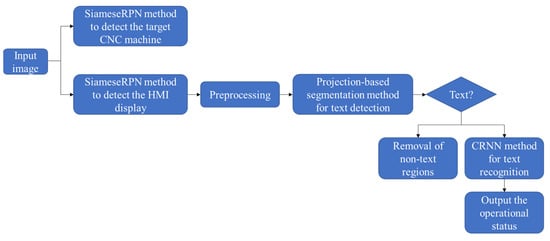
Figure 1.
The flowchart of the proposed intelligent manufacturing approach.
3.1. Siamese Region Proposal Network (Siameserpn) Architecture
Siamese region proposal network is proposed for the target detection consists of two subnetworks: Siamese neural network and the region proposal network. The framework of SiameseRPN is shown in Figure 2.
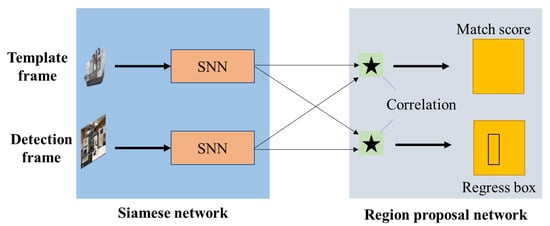
Figure 2.
The architecture of proposed SiameseRPN method.
3.1.1. Siamese Neural Network
The Siamese Neural Network (SNN) network [22] has been proven effective in the object tracking domain. It uses two branches, which share the same parameters, to learn the similarity between each other. The objective of SNN is to understand the embedding space, which places similar items nearby. In other words, SNN is trained with positive and negative pairs of objects, where positive pairs correspond to samples that need to stay close in the embedding space while negative pairs need to stay far away. Although SNN has drawn significant attention because of its balanced accuracy and speed, it lacks bounding box regression. It has to do a multiscale test to locate the video targets, making it less elegant. This study integrated a region proposal network with SNN to address this drawback.
In this study, SNN adopts a convolutional neural network without padding to extract the features. Assume the term LT represents the translation operator of the kernel; then remove all the paddings to satisfy the full convolution with strike k.
In Equation (1) [22], h is a fully convolutional function with integer stride k that maps signals to signals for any translation τ:
h(Lkτx) = Lτh(x)
In this subnetwork, the template frame and the detection frame are fed into the SNN as inputs. The template frame is the previous frame in the video and the detection frame is the current frame in the video. In addition, these two branches have the same hyper-parameters and transformations. For convenience, two outputs of the SNN are represented by M(z) and M(x), which are the feature map representations of the template branch and detection branch.
3.1.2. Region Proposal Network
The region proposal network (RPN) is first proposed in Faster-RCNN [21], which can extract precise candidate regions quickly and efficiently. Therefore, it makes proposal generation very effective while achieving high accuracy.
In this subnetwork, RPN consists of two parts: pairwise correlation and supervision. The supervision consists of two branches: regression and classification. The regression is to generate the candidate regions, and the classification is to distinguish the foreground and background of input images. If n anchors are automatically generated, RPN needs 2n representation channels for the classification task and 4n presentation channels for the regression task. Therefore, the pairwise correlation needs to divide M(z) into two datasets [M(z)]cls and [M(z)]reg, and divide M(x) into [M(x)]cls and [M(x)]reg. Then, [M(z)] is used as the correlation kernel to compare similarity with [M(x)]. Finally, the regression correlation Creg and classification correlation Ccls are computed through Equation (2) [22]:
where [M(z)]reg and [M(z)]cls are used as convolutional kernels, and the sign * is the convolution operation.
Creg = [M(z)]reg * [M(x)]reg, Ccls = [M(z)]cls * [M(x)]cls
Smooth L1 loss function with normalized coordinates and cross-entropy loss function are used for regression and classification, respectively. If Px, Py, Pw, Ph represent the coordinates of the center point, the width and the height of predicted bounding boxes, and Tx, Ty, Tw, Th represent those parameters of the ground truth. Then normalized distances between the prediction and ground truth can be computed. RPN is optimized by minimizing the loss function in Equation (3) [22]:
where λ is the hyper-parameter to balance the performance of regression and classification. Lreg is the loss function for regression, and Lcls is loss function for classification.
Loss = Lcls + λLreg
3.2. Working Status Recognition
The study proposes a novel text recognition method combining HOG and CRNN to accurately and efficiently identify the working status of the CNC machine. This method consists of two stages: text detection using projection-based segmentation [23], and text recognition using convolutional recurrent neural network.
The proposed segmentation algorithm has three steps. First, the projection scans horizontally to determine the upper and lower bounds of the text area. Second, the projection scans vertically to define the left and right bounds of the text area, and then bounding boxes containing the text information are generated. Finally, the non-text regions are removed and the feature maps of text regions are extracted for recognition.
Before applying this segmentation algorithm, some pre-processing steps are adopted. First, transform the color images into grayscale images. The pixel value is from 0 to 255 in a grayscale image. Second, the binarization will convert the grayscale images to binary images using thresholding. Pixels with a greater value than the threshold P are replaced with white color and other pixels are replaced with black color. Here the value of the black pixel is set to one, and the value of the white pixel is set to zero. That is:
Value(i, j) = 1, pixel(i, j) < P
Value(i, j) = 1, pixel(i, j) > P
(0 < i < width, 0 < j < height)
Value(i, j) = 1, pixel(i, j) > P
(0 < i < width, 0 < j < height)
Width and height are two image parameters, and m is a variable threshold according to the image background color. The number of black pixels accounts by the Equation:
Here divide the whole image into N parts with the same height and width. Then, an appropriate threshold Q is set to separate the text and non-text pixels. In the Equation (6), when pixelRow [j] > Q, it is set to one, otherwise it is set to zero:
Horizontal [j] = 1, pixelRow[j] > Q
Horizontal [j] = 1, pixelRow[j] < Q
(0 < j < height)
Horizontal [j] = 1, pixelRow[j] < Q
(0 < j < height)
Horizontal [j] is calculated, traversing the entire array. When the array’s value changes from zero to one, record this pixel as the start point. When the array’s value changes from one to zero, record this pixel as the endpoint. Finally, the text bounding boxes are generated.
After text detection, CRNN [24] is used to recognize the detected text. The framework of CRNN used in this study is shown in Figure 3. It consists of three subnetworks: convolutional layer, recurrent layer, and transcription layer. The convolutional layer automatically extracts feature map sequences from input images. Then the extracted feature sequences are fed into the recurrent network to predict each feature sequence. The transcription layer is used to translate each frame prediction generated in the recurrent layer and group them into a labeled sequence. The main benefit of the CRNN is that it can be trained with one loss function despite being composed of different network architectures.
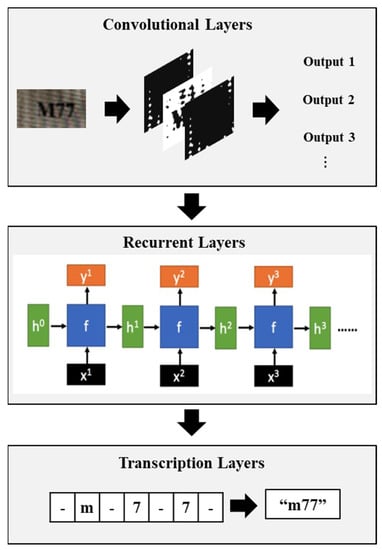
Figure 3.
The architecture of CRNN.
The convolutional layer in CRNN is modified from a standard CNN model by removing the fully connected layers. It extracts feature map representation from an input image. All the input images are scaled to the same size in the pre-processing step. Then feature vector sequence is obtained after the feature maps are extracted in the convolutional layer. To keep the order of the text unchanged, each feature vector is generated from left to right on the feature maps, and the i-th feature vector is the concatenation of the i-th columns of all the feature maps. Finally, those sequences will be fed into the recurrent layer as inputs.
The feature maps are divided into many rectangle regions with a fixed width, which is the receptive fields. Each feature vector sequence can represent one rectangle region, which is illustrated in Figure 4.

Figure 4.
The receptive fields.
Although CNN has proven good performance in recognizing the general objects, it is not suitable for text detection because of its various aspect ratios. Those feature maps extracted from the convolutional layer need to be transformed into sequential representations to avoid being affected by the length variation. Therefore, the recurrent layer modified from the recurrent neural network is adopted to solve this problem. The main advantage of RNN is that it has the stable ability to capture the context in a sequence, which is more useful than identifying each character individually because some ambiguous characters can be easily predicted by observing the contexts.
The transcription layer aims to convert the predicted labeled distribution into a label sequence with the highest conditional probability. Temporal Classification (CTC) [36] is used to calculate the conditional probability. The conditional probability in this study is defined as the label sequence conditioned on the per-frame prediction. The expression of the conditional probability is shown in Equation (7) [24]:
where l is the label sequence, y is the predicted labeled distribution obtained from the recurrent layer (y = y1, y2… yT), where T is the length of the input sequence. B is a mapping function, which maps the sequence onto l by removing the duplicate labels and blank labels. For example, B maps the sequence “-m-7-7-” (“-“ represents blank label) onto “m77”, which is shown in Figure 3.
3.3. Data Augmentation
Although this study adopts enough data to train the proposed model, images of CNC machines tend not to have extensive features due to the limited number of different CNC machines. As a result, increasing the diversity of the training data is widely used to improve the generalization and reduce overfitting [37]. Some geometric distortions are randomly added in this study, including rotation, translation, scaling, vertical flipping, and image distortions, such as Gaussian blur and noise.
3.4. Transfer Learning
Deep learning models often require a large number of input images as training data. However, it is tough to collect enough images for some applications. Transfer learning provides an alternative strategy to address this problem [38] by using a pre-trained deep learning model as a starting point for another training task rather than building a model from scratch. This study adopted the modified AlexNet pre-trained from ImageNet with the parameters [39], significantly improving training efficiency.
4. Experiments and Results
4.1. Robot System Structure
Figure 5 shows the DOBOT CR5 manipulator used in the robot system. It is fixed on a moveable desk that can move around the working environment. Specifications of this manipulator are demonstrated in Table 1. A webcam with 1920 × 1080 pixels resolution is mounted on the top of the robot arm, used to sense the surrounding environment.
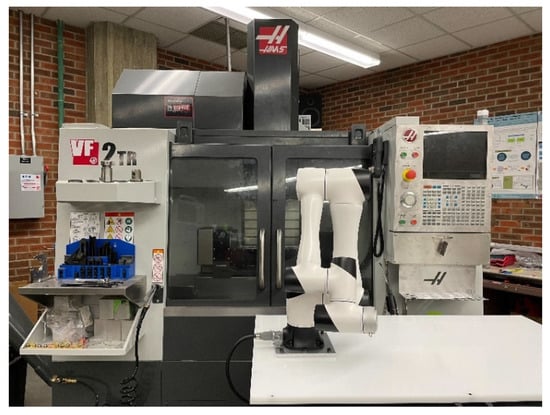
Figure 5.
The structure of robot system.

Table 1.
Specifications of robot manipulator.
4.2. Training Details
The webcam was used to collect the CNC machine and HMI images. The dataset includes training and testing images with a resolution of 960 × 1080. Images were gathered from different positions in our lab. Two hundred images, including 160 training images and 40 testing images, are used to train and test the developed models. The experiments were conducted on a laptop equipped with an Intel Core i7-8750H 4.0 GHz CPU and a single NVIDIA GeForce GTX 1060 under the Ubuntu 18.04 64-bit operating system.
During the training process, Stochastic Gradient Descent (SGD) is adopted to train the proposed SiameseRPN based on the pre-trained SNN model using ImageNet. In addition, picking positive and negative training samples is also necessary. The criterion used in the target CNC machine detection and HMI detection tasks is based on intersection over union (IoU) and two thresholds Thigh and Tlow. When the predicted bounding boxes that have IoU > Thigh with respect to the ground truth, they are considered positive samples, which means the correct results. When the IoU < Tlow, those are considered negative samples and will be removed from the results; the Thigh and Tlow are set as 0.3 and 0.6 in this study, respectively.
4.3. Evaluation
This section evaluates the proposed methods using the video recorded by the webcam mounted on the robot manipulator in the lab environment. Figure 6 shows the case study for detecting the target CNC machine and HMI display. The robot system moves from the lab door toward the target CNC machine and records the real-time video through the mounted camera. Based on the proposed SiameseRPN method, the target CNC machine and HMI display are recognized and located using green and red bounding boxes, respectively. Figure 7 presents particular examples of recognizing the text information on the HMI display using the proposed working status recognition method, such as the basic instruction information and G-codes. Once identifying the text, it is converted into machine-readable text that assists the autonomous robot system in recognizing the real-time working status of the machine, which is significant for the robot system to achieve further decision-making and execution actions to tackle the emergency and abnormal conditions in a completely autonomous environment.
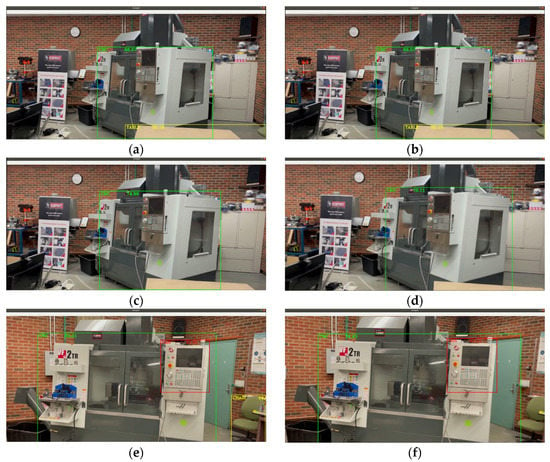

Figure 6.
Validation results for the target CNC machine and HMI detection. (a–d) Detect the target CNC machine in the green bounding box, and obstacles such as the table in the yellow bounding box; (e–g) detect the HMI in the red bounding box.
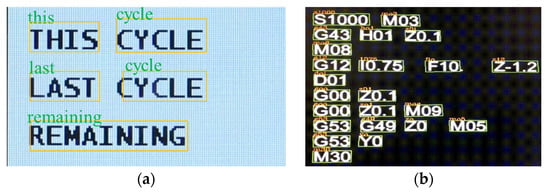
Figure 7.
Text recognition examples for recognizing the information on HMI display. (a) Basic instructions recognition; (b) G-code recognition.
4.4. Results
For the target CNC machine detection, the contrastive loss of the model is plotted in Figure 8. It can be observed that the loss for training and validation achieved 0.127 and 0.112, respectively.
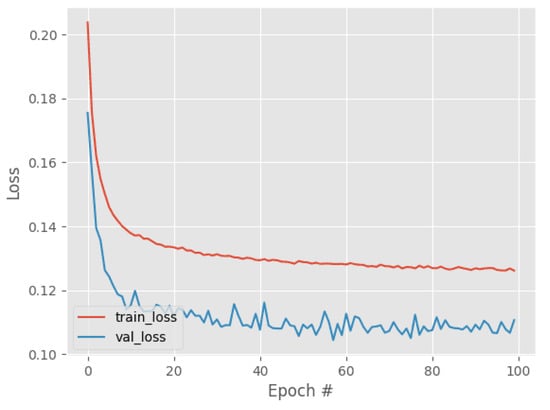
Figure 8.
Contrastive loss for the target CNC machine detection.
Table 2 compares our proposed method with three milestone methods in object detection: Faster-RCNN, SSD, and YOLO. Two hundred frame images from the recorded video were used for the validation. The accuracy of the proposed method is shown in the equation.
where N is the number of correctly detected objects, and T represents the total number of images used.

Table 2.
Comparison of accuracy with benchmark methods (the target CNC machine detection).
For the HMI detection, the accuracy of the proposed method is shown in Figure 9. The model’s accuracy for training and testing can reach 66.3% and 61.9%, respectively. The performance is acceptable considering the size of the dataset. Different parameter values, such as the batch size of training data, the learning rate of the model, and the activation function, have been applied, but they achieved limited benefit. Therefore, increasing the training dataset size would be better to improve the models’ performance.
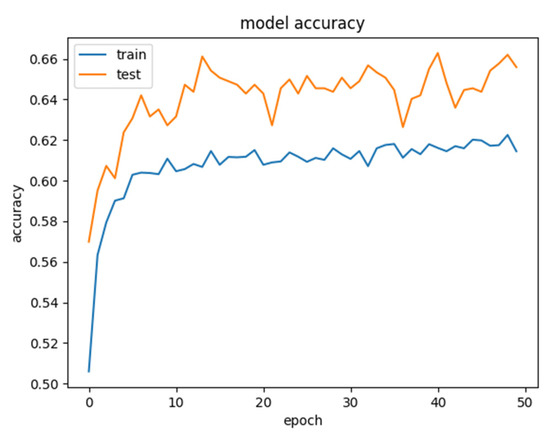
Figure 9.
The accuracy of developed model for HMI detection.
One thousand text samples from the HMI display were adopted to validate the proposed working status recognition method. The benchmark method RNN was compared with the proposed method in this study to estimate the performance of the proposed method. The results for both methods are presented in Table 3. It can be concluded that the proposed method improves the recognition performance in precision without the loss of efficiency.

Table 3.
Compared results for RNN and the proposed method (working status recognition).
5. Discussion and Limitations
This paper presented a novel framework to support autonomous machine tending in lights-out manufacturing, which minimizes the involvement of machine operators during the production process. Most machine tending robot systems adopt collaborative robots that connect to the machine via Ethernet to perform various tasks efficiently under the inspection and tending of onsite operators [40,41,42]. Autonomous mobile robots can use our proposed architecture to achieve fully autonomous machine tending through the integrated vision system and computer vision-based algorithms. The proposed intelligent manufacturing approach can truly achieve autonomous machines, HMI, and emergency detection without the operator’s assistance to support various machine-tending tasks. The proposed methods are flexible, scalable, and adaptable; however, it has some limitations. Text detection and recognition are more sensitive to image quality than general object detection [43]. Sometimes, the mobile camera captures images and videos suffering from poor lighting conditions, such as shadow in the images or reflection of light due to inappropriate shooting distance or angle, making the feature extraction process challenging. Moreover, camera motion or shaking while capturing images can cause text to be blurred [35].
Further research to address the problems mentioned above is necessary to implement the proposed algorithms in autonomous machine-tending applications in a real-world industrial environment. Since the performance of deep learning models largely relies on the size of training data, a bigger and better dataset will be collected in the future and used to improve the proposed approach. Image deblurring [44,45,46] and reflection removal [47,48,49] methods will also be applied to improve the quality of the captured images. Moreover, a reference dictionary containing common abnormal conditions of CNC machines will be designed to match and correct text recognition results.
6. Conclusions
Smart manufacturing has been considered high intelligence, efficiency, accuracy, productivity, and safety compared to traditional manufacturing. With robotics development, vision sensors and computer vision-based algorithms have been widely used in smart manufacturing to tackle complex and hazardous production tasks. Automatic working status recognition and emergency handling through autonomous robot systems have become critical steps in the autonomous manufacturing process, ensuring that machines work properly without human involvement. However, onsite workers still carry out the current inspection of the manufacturing process and machine tending by working with cobots because of lacking an appropriate intelligent manufacturing approach for machine detection and working status recognition. This paper developed an automatic deep learning-based approach to detect a particular CNC machine and the human-machine interface simultaneously in real-time in a complicated lab environment through a camera mounted on the mobile manipulator. In addition, it can identify the working status of the machine by automatically recognizing the text information on the HMI display. According to the validation results, the developed methods are proven to achieve good performances in both accuracy and efficiency. The proposed target CNC machine detection method is 16.5% more accurate than the milestone method Faster-RCNN. The developed machine’s working status recognition method is 10% more accurate than the benchmark algorithm tested. However, the performance of deep learning-based methods often largely relies on the size of training data and image qualities, so a bigger and better dataset will be collected in the future and used to improve the proposed approach.
Author Contributions
Conceptualization, F.J. and R.A.; methodology, F.J.; software, F.J.; validation, F.J.; formal analysis, F.J.; resources, F.J.; data curation, F.J.; writing—original draft preparation, F.J.; writing—review and editing, A.J., Y.M., and R.A.; visualization, F.J.; supervision, Y.M. and R.A. All authors have read and agreed to the published version of the manuscript.
Funding
This research was funded by the NSERC (Grant No. NSERC ALLRP561048-20, and CRDPJ 537378-18) and the Minister of Economic Development, Trade and Tourism (through Major Innovation Project) for funding this project. The APC was funded by the NSERC (Grant No. NSERC ALLRP561048-20, and CRDPJ 537378-18) and the Minister of Economic Development, Trade and Tourism (through Major Innovation Project) for funding this project.
Institutional Review Board Statement
Not applicable.
Informed Consent Statement
Not applicable.
Data Availability Statement
Not applicable.
Acknowledgments
The authors acknowledge the NSERC (Grant No. NSERC ALLRP561048-20, and CRDPJ 537378-18) and the Minister of Economic Development, Trade and Tourism (through Major Innovation Project) for funding this project.
Conflicts of Interest
The authors declare no conflict of interest.
References
- Martinez, P.; Al-Hussein, M.; Ahmad, R. Intelligent vision-based online inspection system of screw-fastening operations in light-gauge steel frame manufacturing. Int. J. Adv. Manuf. Technol. 2020, 109, 645–657. [Google Scholar] [CrossRef]
- Wang, T.-M.; Tao, Y.; Liu, H. Current Researches and Future Development Trend of Intelligent Robot: A Review. Int. J. Autom. Comput. 2018, 15, 525–546. [Google Scholar] [CrossRef]
- Khansari-Zadeh, S.M.; Billard, A. Learning Stable Nonlinear Dynamical Systems with Gaussian Mixture Models. IEEE Trans. Robot. 2011, 27, 943–957. [Google Scholar] [CrossRef] [Green Version]
- Schmitz, A.; Maiolino, P.; Maggiali, M.; Natale, L.; Cannata, G.; Metta, G. Methods and Technologies for the Implementation of Large-Scale Robot Tactile Sensors. IEEE Trans. Robot. 2011, 27, 389–400. [Google Scholar] [CrossRef]
- Levine, S.; Pastor, P.; Krizhevsky, A.; Ibarz, J.; Quillen, D. Learning hand-eye coordination for robotic grasping with deep learning and large-scale data collection. Int. J. Robot. Res. 2017, 37, 421–436. [Google Scholar] [CrossRef]
- Finn, C.; Levine, S. Deep visual foresight for planning robot motion. In Proceedings of the 2017 IEEE International Conference on Robotics and Automation (ICRA), Singapore, 29 May–3 June 2017; pp. 2786–2793. [Google Scholar]
- Jia, F.; Ma, Y.; Ahmad, R. Vision-Based Associative Robotic Recognition of Working Status in Autonomous Manufacturing Environment. Procedia CIRP 2021, 104, 1535–1540. [Google Scholar] [CrossRef]
- Shen, X.; Xie, F.; Liu, X.-J.; Ahmad, R. An NC Code Based Machining Movement Simulation Method for a Parallel Robotic Machine; Huang, Y., Wu, H., Liu, H., Yin, Z., Eds.; Springer International Publishing: Cham, Switzerland, 2017; Volume 10463, pp. 3–13. [Google Scholar]
- Martinez, P.; Ahmad, R.; Al-Hussein, M. Real-time visual detection and correction of automatic screw operations in dimpled light-gauge steel framing with pre-drilled pilot holes. Procedia Manuf. 2019, 34, 798–803. [Google Scholar] [CrossRef]
- Matheson, E.; Minto, R.; Zampieri, E.G.G.; Faccio, M.; Rosati, G. Human–Robot Collaboration in Manufacturing Applications: A Review. Robotics 2019, 8, 100. [Google Scholar] [CrossRef] [Green Version]
- Jia, F.; Tzintzun, J.; Ahmad, R. An Improved Robot Path Planning Algorithm for a Novel Self-Adapting Intelligent Machine Tending Robotic System; Springer International Publishing: Berlin/Heidelberg, Germany, 2020; Volume 86. [Google Scholar]
- Khosravani, M.R.; Nasiri, S.; Reinicke, T. Intelligent knowledge-based system to improve injection molding process. J. Ind. Inf. Integr. 2022, 25, 100275. [Google Scholar] [CrossRef]
- Ying, L.; Li, M.; Yang, J. Agglomeration and driving factors of regional innovation space based on intelligent manufacturing and green economy. Environ. Technol. Innov. 2021, 22, 101398. [Google Scholar] [CrossRef]
- Xu, L.; Li, G.; Song, P.; Shao, W. Vision-Based Intelligent Perceiving and Planning System of a 7-DoF Collaborative Robot. Comput. Intell. Neurosci. 2021, 2021, 5810371. [Google Scholar] [CrossRef] [PubMed]
- Ahmed, I.; Din, S.; Jeon, G.; Piccialli, F.; Fortino, G. Towards Collaborative Robotics in Top View Surveillance: A Framework for Multiple Object Tracking by Detection Using Deep Learning. IEEE/CAA J. Autom. Sin. 2020, 8, 1253–1270. [Google Scholar] [CrossRef]
- Zhou, Z.; Li, L.; Fürsterling, A.; Durocher, H.J.; Mouridsen, J.; Zhang, X. Learning-based object detection and localization for a mobile robot manipulator in SME production. Robot. Comput. Manuf. 2021, 73, 102229. [Google Scholar] [CrossRef]
- Dalal, N.; Triggs, B. Histograms of Oriented Gradients for Human Detection. In Proceedings of the Computer Vision and Pattern Recognition, San Diego, CA, USA, 20–25 June 2005; pp. 886–893. [Google Scholar]
- Felzenszwalb, P.; McAllester, D.; Ramanan, D. A discriminatively trained, multiscale, deformable part model. In Proceedings of the 2008 IEEE Conference on Computer Vision and Pattern Recognition, Anchorage, AK, USA, 23–28 June 2008. [Google Scholar]
- Girshick, R.; Donahue, J.; Darrell, T.; Malik, J. Rich Feature Hierarchies for Accurate Object Detection and Semantic Segmentation. In Proceedings of the 2014 IEEE Conference on Computer Vision and Pattern Recognition, Columbus, OH, USA, 23–28 June 2014; pp. 580–587. [Google Scholar]
- Girshick, R. Fast R-CNN. In Proceedings of the 2015 IEEE International Conference on Computer Vision (ICCV), Santiago, Chile, 7–13 December 2015; pp. 1440–1448. [Google Scholar]
- Ren, S.; He, K.; Girshick, R.; Sun, J. Faster R-CNN: Towards Real-Time Object Detection with Region Proposal Networks. IEEE Trans. Pattern Anal. Mach. Intell. 2017, 39, 1137–1149. [Google Scholar] [CrossRef] [Green Version]
- Leal-Taixé, L.; Canton-Ferrer, C.; Schindler, K. Learning by Tracking: Siamese CNN for Robust Target Association. In Proceedings of the 2016 IEEE Conference on Computer Vision and Pattern Recognition Workshops, Las Vegas, NV, USA, 26 June–1 July 2016. [Google Scholar]
- Lin, H.; Yang, P.; Zhang, F. Review of Scene Text Detection and Recognition. Arch. Comput. Methods Eng. 2020, 27, 433–454. [Google Scholar] [CrossRef]
- Zhu, Y.; Yao, C.; Bai, X. Scene text detection and recognition. Front. Comput. Sci. 2016, 10, 19–36. [Google Scholar] [CrossRef]
- Brisinello, M.; Grbic, R.; Vranjes, M.; Vranjes, D. Review on Text Detection Methods on Scene Images. In Proceedings of the 2019 International Symposium ELMAR, Zadar, Croatia, 23–25 September 2019. [Google Scholar]
- Jaderberg, M.; Simonyan, K.; Vedaldi, A.; Zisserman, A. Reading Text in the Wild with Convolutional Neural Networks. Int. J. Comput. Vis. 2016, 116, 1–20. [Google Scholar] [CrossRef] [Green Version]
- Zhong, Z.; Jin, L.; Zhang, S.; Feng, Z. DeepText: A Unified Framework for Text Proposal Generation and Text Detection in Natural Images. arXiv 2016, arXiv:1605.07314. [Google Scholar]
- He, W.; Zhang, X.-Y.; Yin, F.; Liu, C.-L. Deep Direct Regression for Multi-oriented Scene Text Detection. In Proceedings of the 2017 IEEE International Conference on Computer Vision (ICCV), Venice, Italy, 22–29 October 2017; pp. 745–753. [Google Scholar]
- Su, B.; Lu, S. Accurate Scene Text Recognition Based on Recurrent Neural Network. In Asian Conference on Computer Vision; Springer: Cham, Switzerland, 2015; Volume 9003, pp. 35–48. [Google Scholar]
- Shi, B.; Bai, X.; Yao, C. An End-to-End Trainable Neural Network for Image-Based Sequence Recognition and Its Application to Scene Text Recognition. IEEE Trans. Pattern Anal. Mach. Intell. 2016, 39, 2298–2304. [Google Scholar] [CrossRef] [Green Version]
- Lee, C.-Y.; Osindero, S. Recursive Recurrent Nets with Attention Modeling for OCR in the Wild. In Proceedings of the 2016 IEEE Conference on Computer Vision and Pattern Recognition (CVPR), Las Vegas, NV, USA, 27–30 June 2016; pp. 2231–2239. [Google Scholar]
- Bahdanau, D.; Cho, K.; Bengio, Y. Neural machine translation by jointly learning to align and translate. In Proceedings of the 3rd International Conference on Learning Representations, ICLR 2015, San Diego, CA, USA, 7–9 May 2015; pp. 1–15. [Google Scholar]
- Liao, M.; Shi, B.; Bai, X.; Wang, X.; Liu, W. TextBoxes: A fast text detector with a single deep neural network. In Proceedings of the 31st AAAI Conference on Artificial Intelligence, San Francisco, CA, USA, 4–9 February 2017; pp. 4161–4167. [Google Scholar]
- Hradiš, M.; Kotera, J.; Zemčík, P.; Šroubek, F. Convolutional Neural Networks for Direct Text Deblurring. In Proceedings of the British Machine Vision Conference, Swansea, UK, 7–10 September 2015; pp. 6.1–6.13. [Google Scholar]
- Mahajan, S.; Rani, R. Text detection and localization in scene images: A broad review. Artif. Intell. Rev. 2021, 54, 4317–4377. [Google Scholar] [CrossRef]
- Graves, A.; Liwicki, M.; Fernández, S.; Bertolami, R.; Bunke, H.; Schmidhuber, J. Unconstrained online handwriting recognition with recurrent neural networks. In Advances in Neural Information Processing System; MIT Press: Cambridge, MA, USA, 2008; pp. 1–8. [Google Scholar]
- Dieleman, S.; Willett, K.W.; Dambre, J. Rotation-invariant convolutional neural networks for galaxy morphology prediction. Mon. Not. R. Astron. Soc. 2015, 450, 1441–1459. [Google Scholar] [CrossRef]
- Zheng, Y.; Mamledesai, H.; Imam, H.; Ahmad, R. A Novel Deep Learning-based Automatic Damage Detection and Localization Method for Remanufacturing/Repair. Comput. Des. Appl. 2021, 18, 1359–1372. [Google Scholar] [CrossRef]
- Russakovsky, O.; Deng, J.; Su, H.; Krause, J.; Satheesh, S.; Ma, S.; Huang, Z.; Karpathy, A.; Khosla, A.; Bernstein, M.; et al. ImageNet Large Scale Visual Recognition Challenge. Int. J. Comput. Vis. 2015, 115, 211–252. [Google Scholar] [CrossRef] [Green Version]
- Necula, M.; Câmpean, E.; Morar, L. Defining the Characteristics Needed for the Cobots Design Used for the Supply of Cnc Machines. Acta Tech. Napoc. 2022, 65, 171–178. [Google Scholar]
- Al-Hussaini, S.; Thakar, S.; Kim, H.; Rajendran, P.; Shah, B.C.; Marvel, J.A.; Gupta, S.K. Human-Supervised Semi-Autonomous Mobile Manipulators for Safely and Efficiently Executing Machine Tending Tasks. arXiv 2020, arXiv:2010.04899. [Google Scholar]
- Annem, V.; Rajendran, P.; Thakar, S.; Gupta, S.K. Towards Remote Teleoperation of a Semi-Autonomous Mobile Manipulator System in Machine Tending Tasks. In Proceedings of the ASME 2019 14th International Manufacturing Science and Engineering Conference, Erie, PA, USA, 10–14 June 2019. [Google Scholar]
- Long, S.; He, X.; Yao, C. Scene Text Detection and Recognition: The Deep Learning Era. Int. J. Comput. Vis. 2020, 129, 161–184. [Google Scholar] [CrossRef]
- Wojna, Z.; Gorban, A.N.; Lee, D.-S.; Murphy, K.; Yu, Q.; Li, Y.; Ibarz, J. Attention-Based Extraction of Structured Information from Street View Imagery. In Proceedings of the 2017 14th IAPR International Conference on Document Analysis and Recognition (ICDAR), Kyoto, Japan, 9–15 November 2017; Volume 1, pp. 844–850. [Google Scholar]
- Nadeem, M.S.; Hussain, S.; Kurugollu, F. Textual Deblurring using Convolutional Neural Network. TechRxiv 2021. [Google Scholar] [CrossRef]
- Wu, C.; Du, H.; Wu, Q.; Zhang, S. Image Text Deblurring Method Based on Generative Adversarial Network. Electronics 2020, 9, 220. [Google Scholar] [CrossRef] [Green Version]
- Amanlou, A.; Suratgar, A.A.; Tavoosi, J.; Mohammadzadeh, A.; Mosavi, A. Single-Image Reflection Removal Using Deep Learning: A Systematic Review. IEEE Access 2022, 10, 29937–29953. [Google Scholar] [CrossRef]
- Li, C.; Yang, Y.; He, K.; Lin, S.; Hopcroft, J.E. Single Image Reflection Removal Through Cascaded Refinement. In Proceedings of the 2020 IEEE/CVF Conference on Computer Vision and Pattern Recognition, CVPR 2020, Seattle, WA, USA, 13–19 June 2020; pp. 3562–3571. [Google Scholar]
- Li, Y.; Liu, M.; Yi, Y.; Li, Q.; Ren, D.; Zuo, W. Two-Stage Single Image Reflection Removal with Reflection-Aware Guidance. arXiv 2020, arXiv:2012.00945. [Google Scholar]
Publisher’s Note: MDPI stays neutral with regard to jurisdictional claims in published maps and institutional affiliations. |
© 2022 by the authors. Licensee MDPI, Basel, Switzerland. This article is an open access article distributed under the terms and conditions of the Creative Commons Attribution (CC BY) license (https://creativecommons.org/licenses/by/4.0/).